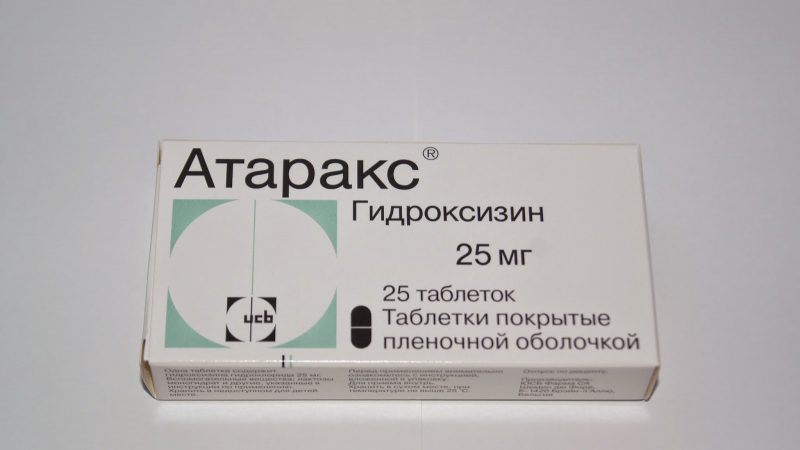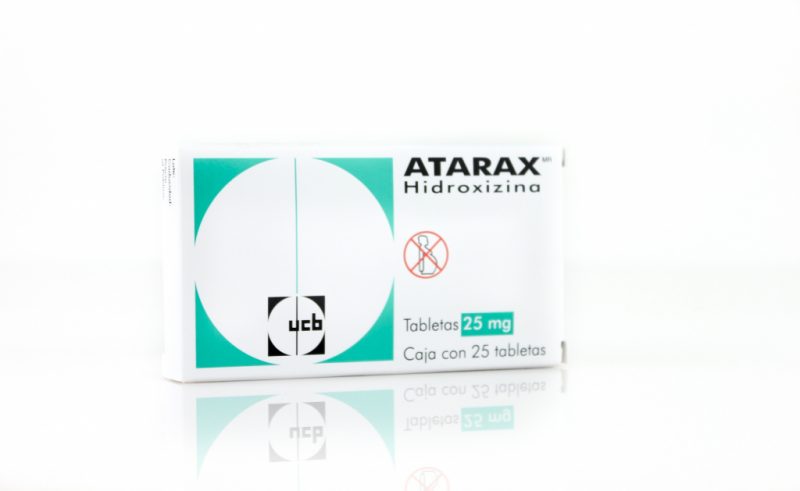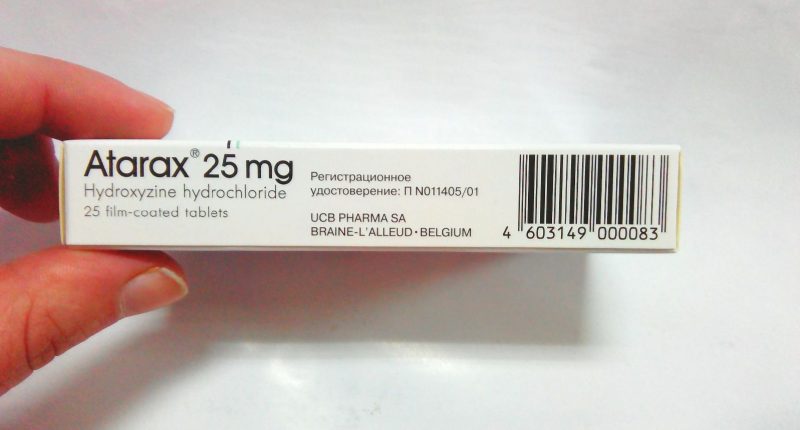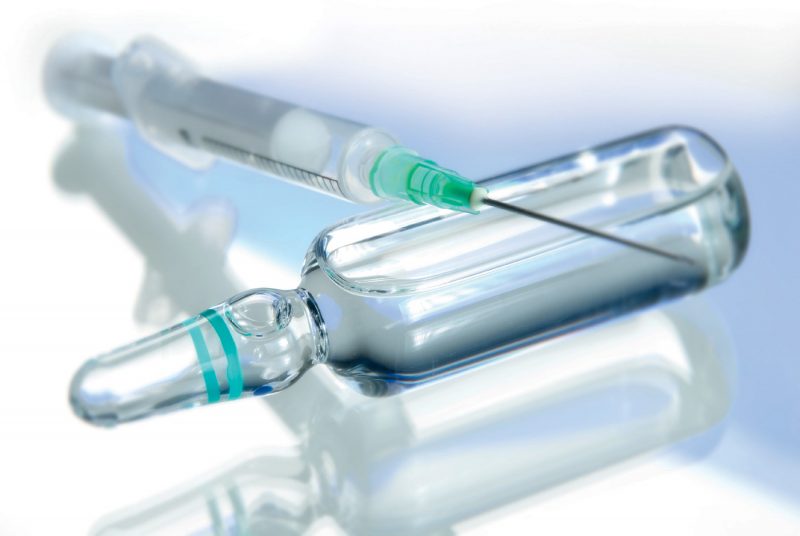Increased anxiety, nervous tension - conditions that complicate professional activities, family life, rest. Atarax helps to cope with unreasonable fears and nervousness. A mild sedative, anxiolytic is not addictive and does not impair intellectual activity.
Material Content:
- 1 Composition and release forms
- 2 Pharmacological action and pharmacokinetics
- 3 Why is Atarax prescribed for children and adults?
- 4 Instructions for use of the drug
- 5 During pregnancy and lactation
- 6 Drug interaction
- 7 Atarax Compatibility with Alcohol
- 8 Contraindications, side effects and overdose
- 9 Analogs of tranquilizer
Composition and release forms
Immediately after its creation, this medicine was used only as a treatment for allergies. Researchers later noticed that the pills have not only a strong antihistamine effect, but also a calming effect. The active ingredient in the drug, hydroxyzine, acts as a tranquilizer when the concentration is increased. This term means "soothing."
Hydroxysine hydrochloride in each tablet contains 25 mg. For v / m injection, a solution is used. The concentration of the active ingredient in the Atarax liquid preparation is 50 mg / ml. The volume of solution in one ampoule is 2 ml.
Pharmacological action and pharmacokinetics
The pharmacological group to which the Atarax tablets belong is called anxiolytics (tranquilizers). Hydroxyzine reduces the excitability of the parts of the brain that are responsible for the release of hormones and the strength of emotional reactions. Anxiolytic eliminates anxiety. Treatment with drugs of this group is carried out under the supervision of specialists.
Pharmacological properties of hydroxyzine:
- relaxing (acts as a muscle relaxant);
- anti-anxiety;
- antihistamines;
- antiphobic;
- antiemetic;
- sleeping pills;
- sedatives.
"Atarax" is a psychotropic drug that suppresses phobias, negative emotions, internal tension. The hypnotic effect of the drug is to accelerate falling asleep, improving the quality of night rest. Thanks to the reception of Atarax, the number of causeless awakenings at night is reduced, and the duration of a quiet sleep is extended.
The medicine does not cause mental dependence or withdrawal, and also has other positive qualities. Unfortunately, along with the relaxation of skeletal muscles, weakness and apathy can occur.
It is important that in the process of treatment cognitive functions (memory, thinking) do not suffer.
Hydroxyzine is rapidly and almost completely absorbed in the intestine. The bioavailability of the drug reaches 80% when taking tablets and / m injections. The main volume is concentrated not in plasma, but in tissues. Hydroxyzine, like other tranquilizers, is able to penetrate the blood-brain (between the systemic circulation and the central nervous system), as well as the placental barrier.
The medicine breaks down in the liver. About 1% of unchanged hydroxyzine is excreted in the urine. The main metabolite is cetirizine, known as an antihistamine that does not cause drowsiness.
Why is Atarax prescribed for children and adults?
The tool helps to reduce emotional stress, anxiety, psychomotor irritability. Atarax is also prescribed for pruritus. Antihistamine action begins 15-30 minutes after the use of the drug and lasts for 4 days.
If you know what “Atarax” is prescribed for, then with the use of one tablet you can replace several drugs (sedatives, sleeping pills, antihistamines).
Indications:
- allergic skin itching;
- withdrawal syndrome (alcohol);
- a combination of anxiety and depression;
- excessive irritability;
- psychomotor agitation;
- adaptation disorders;
- for sedation;
- neurasthenia;
- panic;
- VSD.
It is advisable to cope with everyday worries, domestic and professional troubles without drugs.
Atarax is prescribed for children with dermatoses (urticaria, allergic and other types of dermatitis, eczema). However, this antihistamine does not eliminate the cause of the unusual reaction of the body.
Instructions for use of the drug
The tablets are taken orally. Ampoules are used for IM injections.
Atarax tablets, 25 mg
The instructions for use offer various options for prescribing the drug to adults. The daily dosage varies from 25 to 100 mg (1 to 4 tablets). The maximum daily dose is 250 to 300 mg, or 10 to 12 tablets. Take no more than 4 tablets once.
Atarax treatment options:
- with anxiety, withdrawal symptoms and other indications - ½ tablet in the morning and afternoon, 2 in the evening;
- with muscle cramps - 2 tablets three times a day;
- with insomnia - 2 tablets at night.
Elderly should reduce dosage. If there are no negative effects, then the number of tablets is gradually increased to 4 pcs./day.
Dose for the child - 1 - 2.5 mg per kilogram of weight. If the operation is to be performed the next day, then Atarax is given once in the evening, then one hour before the operation. Dose - 1 mg / kg.
Solution for intramuscular administration in ampoules
Atarax v / m should be prescribed by a doctor. After the injection, patients often complain of pain at the injection site.
During pregnancy and lactation
These are absolute contraindications for the treatment of Atarax. The drug is forbidden to take during childbirth. During lactation, if the doctor prescribes the drug, breast-feeding is stopped for the duration of treatment.
Drug interaction
As a tool that affects the functions of the central nervous system, Atarax enhances similar drugs.Therefore, while taking with narcotic painkillers, other tranquilizers (anxiolytics), sleeping pills, barbiturates, a reduction in dosages and frequency of administration is required. The same rule applies to drugs used for anesthesia that contain ethyl alcohol.
With the combined use of Atarax with other sedative drugs, the concentration of attention decreases. Therefore, at the time of treatment, you should abandon activities that require the speed of psychomotor reactions, for example, from driving vehicles.
Atarax Compatibility with Alcohol
Drinks containing ethanol are not consumed during treatment with the drug. Compatibility of “Atarax” and alcohol is impossible, since the effect of the tranquilizer is enhanced, changed.
As a result, the medicine does not calm the nervous system, but suppresses the central nervous system. Severe consequences can occur up to respiratory arrest.
Atarax enhances alcohol toxicity. The negative effect of ethanol on the central nervous system increases. "Cocktail" "Atarax" + alcohol causes drowsiness or aggression, is the cause of pathological intoxication.
Contraindications, side effects and overdose
"Atarax" in tablets is not prescribed for patients younger than 2 to 3 years old, and in injections - for infants up to 1 year old. Contraindication is hypersensitivity to the active ingredient and / or excipients. The same rule applies to piperazine derivatives (which include hydroxyzine), cetirizine, ethylenediamine, aminophylline.
When prescribing "Atarax", the presence of various pathologies in the patient is taken into account. Particular care requires the use of this tool for myasthenia gravis, seizures, dementia, high eye pressure, and diseases of the prostate gland.
Side effects of using the medicine are increased sweat, general weakness, lethargy, drowsiness, and tachycardia.
Other adverse reactions to Atarax:
- dizziness;
- insomnia;
- hypotension;
- nausea;
- constipation.
The likelihood of developing most negative manifestations is low. Most often, side effects are noted in the elderly at the beginning of treatment with Atarax. In such a situation, it is recommended to reduce the dose or stop treatment.
Analogs of tranquilizer
There are other anxiolytic drugs used to treat severe anxiety, alcohol withdrawal, and other similar situations.
Analogs of Atarax, including group:
- "Relanium";
- "Phenazepam";
- Grandaxinum;
- Diazepam
- "Phenibut."
The preparations "Relanium", "Diazepam", "Sibazon" contain the same active substance, which refers to benzodiazepines. This is the second generation of anxiolytics (hydroxyzine - the first). The lists of indications and contraindications have much in common with Atarax.
"Relanium" and "Diazepam" are characterized by a strong muscle relaxant and long-lasting anxiolytic effect. The effect of the drug of the same group is most pronounced - "Phenazepam".
Atarax acts mildly compared to benzodiazepines. These drugs, in turn, are distinguished by a wider range of pharmacological properties.
Working patients often have a negative attitude to strong tranquilizers, after which it is difficult to “get together” in the afternoon: drowsiness prevails, lethargy is felt. In such cases, the so-called “daytime” anxiolytics are preferable. Grandaxin is one of them. This derivative of diazepine is widely used in neurology, often prescribed for neurosis and neurosis-like conditions, autonomic disorders.
To understand which is better - “Atarax” or “Grandaxin”, you need to carefully consider the lists of indications and contraindications. Grandaxinum is a newer and more versatile drug. The tool can be taken to reduce the disorders accompanying emotional stress, depression, menopause, PMS. The absence of pronounced muscle relaxant action allows you to not interrupt treatment during the day.
Aminophenylbutyric acid in the composition of the drug "Phenibut" - anxiolytic and nootropic. The drug is prescribed for dizziness due to labyrinthitis, disorders of the vestibular apparatus, with insomnia, alcohol withdrawal.
The medicine can be used for stuttering and enuresis in children. Parents should discuss with the children's neurologist which drug is best for the child - Atarax or Phenibut. The second remedy has fewer contraindications and negative effects on the body.
Atarax is prescribed for neurological and mental illnesses, chronic alcoholism, withdrawal symptoms, and dermatoses. Patients like the mild soothing effect of the drug. The tool copes well with sleep disorders that occur against a background of increased anxiety.






















